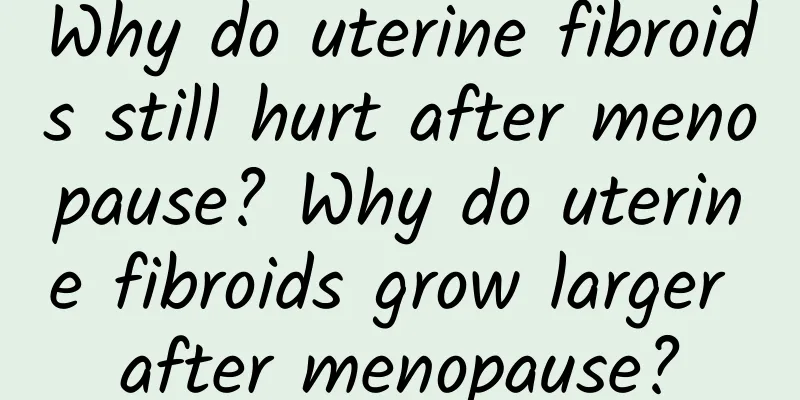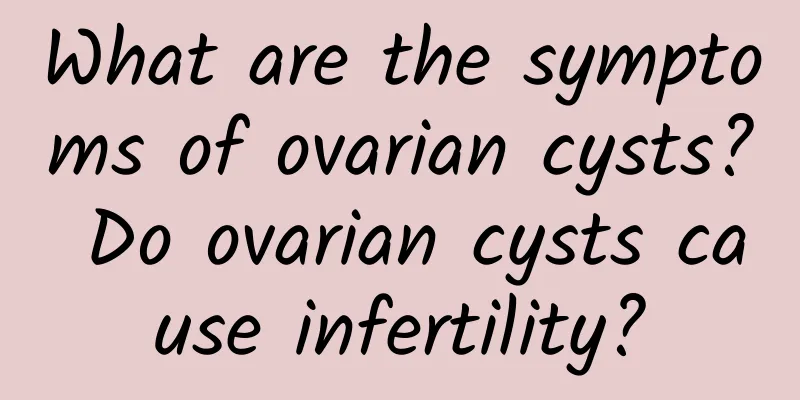Why do uterine fibroids still hurt after menopause? Why do uterine fibroids grow larger after menopause?

|
Why do uterine fibroids still hurt after menopause? Why do uterine fibroids grow larger after menopause? Postmenopausal uterine fibroids are a common gynecological disease. As women's hormone levels decrease after menopause, uterine fibroids will gradually shrink or stabilize, but some patients will experience pain symptoms, and there are also cases where the fibroids grow larger. This article will explain why postmenopausal uterine fibroids hurt and why they grow larger, and analyze the possible causes. Causes of pain 1. Residual uterine fibroid tissue After menopause, the endometrium gradually shrinks. If there is residual uterine fibroid tissue, these tissues may be compressed or irritated, causing pain. In this case, the pain of uterine fibroids is usually cyclical and related to the menstrual cycle. Residual uterine fibroid tissue may also cause endometriosis, which in turn leads to pelvic inflammation and aggravates the degree of pain. 2. Malignant changes Although the rate of malignant changes in postmenopausal uterine fibroids is low, it is not completely impossible. When uterine fibroids undergo malignant changes, they can cause pain. This pain is usually persistent and accompanied by other uncomfortable symptoms, such as abdominal distension or ascites. 3. Uterine fibroids combined with other diseases Some patients have other gynecological diseases after menopause, such as endometriosis, adenomyosis, etc. The presence of these diseases may increase the degree of pain and make the pain of postmenopausal uterine fibroids more obvious. Causes of enlargement 1. Imbalanced hormone levels After menopause, hormone levels in women gradually decrease, which causes uterine fibroids to shrink slowly or remain stable. However, some patients may experience enlarged uterine fibroids. This may be related to an imbalance in hormone levels, such as an increase in estrogen levels. Estrogen is an important factor in the growth of uterine fibroids. If estrogen levels increase, it may stimulate the growth of uterine fibroids and cause them to become larger. 2. Other lifestyle and environmental factors In addition to endogenous factors, exogenous factors may also play a role in the growth of postmenopausal uterine fibroids. For example, lifestyle factors such as obesity, lack of exercise, and poor diet are all associated with the growth of uterine fibroids. In addition, long-term exposure to chemicals and environmental pollutants may also cause the growth of uterine fibroids. 3. Influence of other diseases Postmenopausal patients usually suffer from other chronic diseases, such as hypertension, diabetes, etc. These diseases may affect the patient's lifestyle and treatment compliance, thus leading to the enlargement of uterine fibroids. There are many possible reasons why postmenopausal uterine fibroids hurt and grow. Pain may be caused by residual uterine fibroid tissue, malignant changes, or uterine fibroids combined with other diseases. Enlargement may be related to imbalanced hormone levels, lifestyle and environmental factors, and the influence of other diseases. In view of these reasons, patients should seek medical treatment in time for comprehensive treatment, including drug therapy, surgical treatment, and improved lifestyle. Under the guidance of a doctor, patients can effectively control the pain of postmenopausal uterine fibroids and prevent them from further enlargement. |
Recommend
What are the clinical symptoms of adnexitis?
Adnexitis is a common gynecological disease among...
What are the symptoms of uterine infection after abortion? These 3 symptoms will appear
Abortion is a way to end pregnancy artificially. ...
How to eat well for patients with vulvar itching
I believe that many women have experienced the sy...
Experts answer common questions about the cost of treating cervical hypertrophy
The cost of treating cervical hypertrophy is a co...
Is curettage equivalent to having another abortion?
Is curettage equivalent to having another abortio...
How to care for vulvar leukoplakia in daily life
Vulvar leukoplakia is now a very common female di...
What are the dangers of pelvic effusion in women?
Pelvic effusion is one of the most common disease...
The price of progesterone for irregular menstruation
How much does it cost for women to treat menstrua...
What are the items to check for premature ovarian failure
Premature ovarian failure refers to amenorrhea in...
What are the harmful effects of uterine fibroids?
Uterine fibroids are a relatively serious gynecol...
Shufei chicken breast is low in fat and the fastest way to lose weight? Nutritionist: Long-term consumption may lead to constipation, hypoglycemia and other 5 major problems
Office workers who want to gain muscle and lose f...
Can men take Xiaoyao Pills? Yes.
Xiaoyao Pills are also suitable for male friends....
angry! Winter metabolism is slow, 4 ways to detoxify and reduce belly fat
The climate is cold in winter, the human body'...
The harm of abortion to women
Abortion seriously affects the physical and menta...
Can cervical precancerous lesions be cured if they are not serious?
According to clinical research results, the cause...









